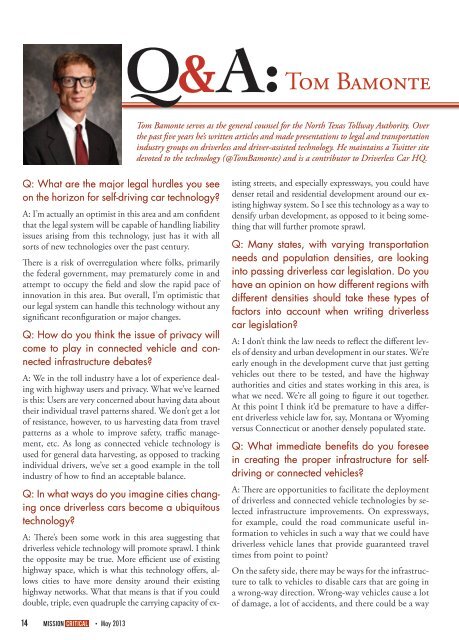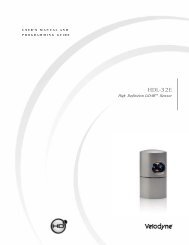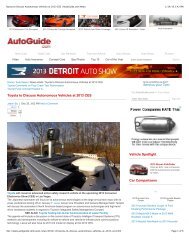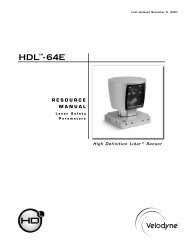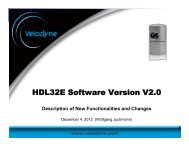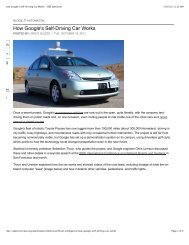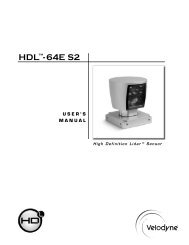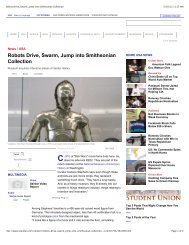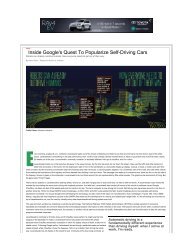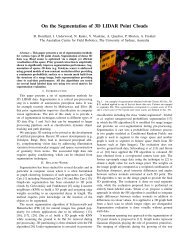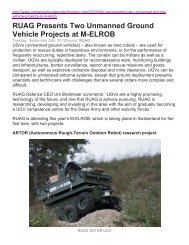Driverless Vehicles Make Inroads in Military - Velodyne Lidar
Driverless Vehicles Make Inroads in Military - Velodyne Lidar
Driverless Vehicles Make Inroads in Military - Velodyne Lidar
Create successful ePaper yourself
Turn your PDF publications into a flip-book with our unique Google optimized e-Paper software.
Q&A: Tom Bamonte<br />
Tom Bamonte serves as the general counsel for the North Texas Tollway Authority. Over<br />
the past five years he’s written articles and made presentations to legal and transportation<br />
<strong>in</strong>dustry groups on driverless and driver-assisted technology. He ma<strong>in</strong>ta<strong>in</strong>s a Twitter site<br />
devoted to the technology (@TomBamonte) and is a contributor to <strong>Driverless</strong> Car HQ.<br />
Q: What are the major legal hurdles you see<br />
on the horizon for self-driv<strong>in</strong>g car technology<br />
A: I’m actually an optimist <strong>in</strong> this area and am confident<br />
that the legal system will be capable of handl<strong>in</strong>g liability<br />
issues aris<strong>in</strong>g from this technology, just has it with all<br />
sorts of new technologies over the past century.<br />
There is a risk of overregulation where folks, primarily<br />
the federal government, may prematurely come <strong>in</strong> and<br />
attempt to occupy the field and slow the rapid pace of<br />
<strong>in</strong>novation <strong>in</strong> this area. But overall, I’m optimistic that<br />
our legal system can handle this technology without any<br />
significant reconfiguration or major changes.<br />
Q: How do you th<strong>in</strong>k the issue of privacy will<br />
come to play <strong>in</strong> connected vehicle and connected<br />
<strong>in</strong>frastructure debates<br />
A: We <strong>in</strong> the toll <strong>in</strong>dustry have a lot of experience deal<strong>in</strong>g<br />
with highway users and privacy. What we’ve learned<br />
is this: Users are very concerned about hav<strong>in</strong>g data about<br />
their <strong>in</strong>dividual travel patterns shared. We don’t get a lot<br />
of resistance, however, to us harvest<strong>in</strong>g data from travel<br />
patterns as a whole to improve safety, traffic management,<br />
etc. As long as connected vehicle technology is<br />
used for general data harvest<strong>in</strong>g, as opposed to track<strong>in</strong>g<br />
<strong>in</strong>dividual drivers, we’ve set a good example <strong>in</strong> the toll<br />
<strong>in</strong>dustry of how to f<strong>in</strong>d an acceptable balance.<br />
Q: In what ways do you imag<strong>in</strong>e cities chang<strong>in</strong>g<br />
once driverless cars become a ubiquitous<br />
technology<br />
A: There’s been some work <strong>in</strong> this area suggest<strong>in</strong>g that<br />
driverless vehicle technology will promote sprawl. I th<strong>in</strong>k<br />
the opposite may be true. More efficient use of exist<strong>in</strong>g<br />
highway space, which is what this technology offers, allows<br />
cities to have more density around their exist<strong>in</strong>g<br />
highway networks. What that means is that if you could<br />
double, triple, even quadruple the carry<strong>in</strong>g capacity of exist<strong>in</strong>g<br />
streets, and especially expressways, you could have<br />
denser retail and residential development around our exist<strong>in</strong>g<br />
highway system. So I see this technology as a way to<br />
densify urban development, as opposed to it be<strong>in</strong>g someth<strong>in</strong>g<br />
that will further promote sprawl.<br />
Q: Many states, with vary<strong>in</strong>g transportation<br />
needs and population densities, are look<strong>in</strong>g<br />
<strong>in</strong>to pass<strong>in</strong>g driverless car legislation. Do you<br />
have an op<strong>in</strong>ion on how different regions with<br />
different densities should take these types of<br />
factors <strong>in</strong>to account when writ<strong>in</strong>g driverless<br />
car legislation<br />
A: I don’t th<strong>in</strong>k the law needs to reflect the different levels<br />
of density and urban development <strong>in</strong> our states. We’re<br />
early enough <strong>in</strong> the development curve that just gett<strong>in</strong>g<br />
vehicles out there to be tested, and have the highway<br />
authorities and cities and states work<strong>in</strong>g <strong>in</strong> this area, is<br />
what we need. We’re all go<strong>in</strong>g to figure it out together.<br />
At this po<strong>in</strong>t I th<strong>in</strong>k it’d be premature to have a different<br />
driverless vehicle law for, say, Montana or Wyom<strong>in</strong>g<br />
versus Connecticut or another densely populated state.<br />
Q: What immediate benefits do you foresee<br />
<strong>in</strong> creat<strong>in</strong>g the proper <strong>in</strong>frastructure for selfdriv<strong>in</strong>g<br />
or connected vehicles<br />
A: There are opportunities to facilitate the deployment<br />
of driverless and connected vehicle technologies by selected<br />
<strong>in</strong>frastructure improvements. On expressways,<br />
for example, could the road communicate useful <strong>in</strong>formation<br />
to vehicles <strong>in</strong> such a way that we could have<br />
driverless vehicle lanes that provide guaranteed travel<br />
times from po<strong>in</strong>t to po<strong>in</strong>t<br />
On the safety side, there may be ways for the <strong>in</strong>frastructure<br />
to talk to vehicles to disable cars that are go<strong>in</strong>g <strong>in</strong><br />
a wrong-way direction. Wrong-way vehicles cause a lot<br />
of damage, a lot of accidents, and there could be a way<br />
14 MISSION CRITICAL • May 2013


